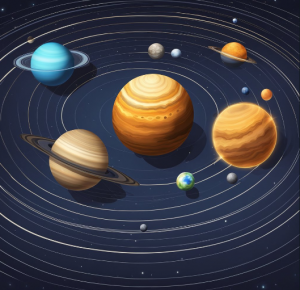Inner Planets vs Outer Planets: A Comparison of Orbital Speeds

Understanding Planetary Motion: How Fast Do Inner Planets Move Compared to Outer Planets?
The motion of planets in the solar system is a fascinating topic that has intrigued scientists for centuries. The speed at which planets move around the sun is determined by their distance from the sun and their mass. The closer a planet is to the sun, the faster it moves, and vice versa. This means that the inner planets, which are closer to the sun, move faster than the outer planets, which are farther away.
The four inner planets of the solar system, Mercury, Venus, Earth, and Mars, are all relatively small and rocky. These planets orbit the sun at a faster speed than the outer planets, which are much larger and composed mainly of gas. Jupiter, Saturn, Uranus, and Neptune are the outer planets of the solar system, and they move at a slower pace than the inner planets.
Comparing Inner and Outer Planets: The Differences in Planetary Motion
The speed at which planets move around the sun is determined by their distance from the sun and their mass. The closer a planet is to the sun, the faster it moves, and vice versa. This means that the inner planets, which are closer to the sun, move faster than the outer planets, which are farther away. The inner planets take less time to complete one revolution around the sun than the outer planets. For example, Earth takes 365.24 days to complete one revolution around the sun, while Neptune takes 164.79 years.
The motion of planets in the solar system is a complex process that depends on various factors, including the gravitational pull of the sun and other planets. The speed at which planets move around the sun is a result of the balance between the gravitational force of the sun and the centrifugal force of the planet. The inner planets move faster than the outer planets because they are closer to the sun and experience a stronger gravitational pull. Understanding the motion of planets in the solar system is essential for scientists to study the history and evolution of the solar system.
Key Takeaways
- The inner planets move faster than the outer planets because they are closer to the sun and experience a stronger gravitational pull.
- The speed at which planets move around the sun is determined by their distance from the sun and their mass.
- The motion of planets in the solar system is a complex process that depends on various factors, including the gravitational pull of the sun and other planets.
Understanding Planetary Motion
Inner Planets Motion
The inner planets, also known as the terrestrial planets, are the four planets closest to the sun: Mercury, Venus, Earth, and Mars. These planets are small and rocky with solid surfaces. They have shorter orbits around the sun, and they rotate slowly on their axis.
The orbital speed of the inner planets increases as you move outward from the sun. For example, Mercury has an orbital speed of 47.87 km/s, while Mars has an orbital speed of 24.077 km/s. The closer a planet is to the sun, the faster it moves in its orbit.
The inner planets also have shorter periods of rotation. For example, Earth rotates once every 24 hours, while Mars rotates once every 24.6 hours. The rotation of the inner planets is influenced by their small size and low mass, which results in weaker gravitational forces than those of the gas giants.
Outer Planets Motion
The outer planets, also known as the gas giants, are the four planets farthest from the sun: Jupiter, Saturn, Uranus, and Neptune. These planets are much larger than the inner planets and are made mostly of gas and ice. They have longer orbits around the sun and rotate much faster on their axis.
The rotational speed of the outer planets decreases as you move outward from the sun. For example, Jupiter rotates once every 9.9 Earth hours, while Neptune rotates once every 16.1 Earth hours. The gas giants have larger masses and more angular momentum than the inner planets, which causes them to rotate faster.
The outer planets also have longer periods of rotation. For example, Jupiter’s day is only 9.9 Earth hours, but its year is 11.86 Earth years. The gas giants also have more moons and are surrounded by rings, which are thought to be the result of collisions between objects in space.
In conclusion, the motion of planets is influenced by their size, mass, and distance from the sun. The gas giants rotate faster and have longer periods of rotation than the inner planets due to their larger mass and angular momentum. The inner planets, on the other hand, rotate slower and have shorter periods of rotation due to their smaller size and weaker gravitational forces.
Comparing Inner and Outer Planets
When it comes to comparing inner and outer planets, there are several key differences to consider. Inner planets, also known as terrestrial planets, are smaller and denser than outer planets, which are also known as gas giants. Inner planets are made up of solid, rocky material, while outer planets are composed mostly of gas and ice.
One major difference between inner and outer planets is their distance from the sun. Inner planets are located closer to the sun than outer planets, which means they have shorter orbits and move faster. For example, Mercury, the closest planet to the sun, has an orbital speed of around 107,000 miles per hour, while Neptune, the eighth planet from the sun, has an orbital speed of around 12,000 miles per hour.
Another key difference between inner and outer planets is their size and mass. Inner planets are smaller and less massive than outer planets. For example, Earth, the largest inner planet, has a mass of around 5.97 x 10^24 kg, while Jupiter, the largest outer planet, has a mass of around 1.90 x 10^27 kg.
Inner planets also rotate more slowly than outer planets. This is due to the conservation of angular momentum, which causes objects to rotate faster when they are closer to the center of mass. Inner planets have smaller cores and less angular momentum than outer planets, which means they rotate more slowly.
Finally, inner planets are geologically active, while outer planets are not. This is because inner planets have cooled igneous rock in their cores, which generates heat and drives geological activity. Outer planets, on the other hand, are composed mostly of gas and ice, which do not generate heat.
In summary, inner planets are smaller, denser, and faster-moving than outer planets. They also rotate more slowly and are geologically active, while outer planets are larger, less dense, and have slower orbits. These differences are due to a combination of factors, including distance from the sun, size and mass, angular momentum, and core composition.
Frequently Asked Questions
What separates the inner and outer planets?
The inner planets are separated from the outer planets by the asteroid belt, a region of space between Mars and Jupiter that is filled with rocky debris. The inner planets are also known as the terrestrial planets because they are rocky and have solid surfaces. The outer planets, on the other hand, are known as gas giants because they are mostly made up of gases like hydrogen and helium.
Do inner planets rotate on an axis?
Yes, all planets in our solar system, including the inner planets, rotate on an axis. This rotation causes day and night cycles on each planet. However, the length of a day on each planet varies. For example, a day on Venus is longer than a year on Venus, while a day on Earth is 24 hours.
Do inner planets have rings?
No, none of the inner planets have rings. Rings are primarily found around the gas giants, such as Saturn, Jupiter, Uranus, and Neptune.
Which rotates faster inner or outer planets?
Generally, the outer planets rotate faster than the inner planets. This is because the outer planets are much larger than the inner planets and have more mass, which causes them to rotate faster. However, there are exceptions to this rule. For example, Venus rotates very slowly, while Jupiter rotates very quickly.
Which planets move the fastest?
Mercury is the fastest planet in our solar system, with an orbital speed of 47.87 km/s. In contrast, Earth has an orbital speed of 29.78 km/s. The outer planets, such as Jupiter, Saturn, Uranus, and Neptune, move more slowly than the inner planets.
Do outer planets move slower?
Yes, the outer planets move more slowly than the inner planets. This is because the outer planets are farther away from the sun and have longer orbital periods. For example, Neptune takes almost 165 Earth years to complete one orbit around the sun, while Mars takes only about 1.88 Earth years.
